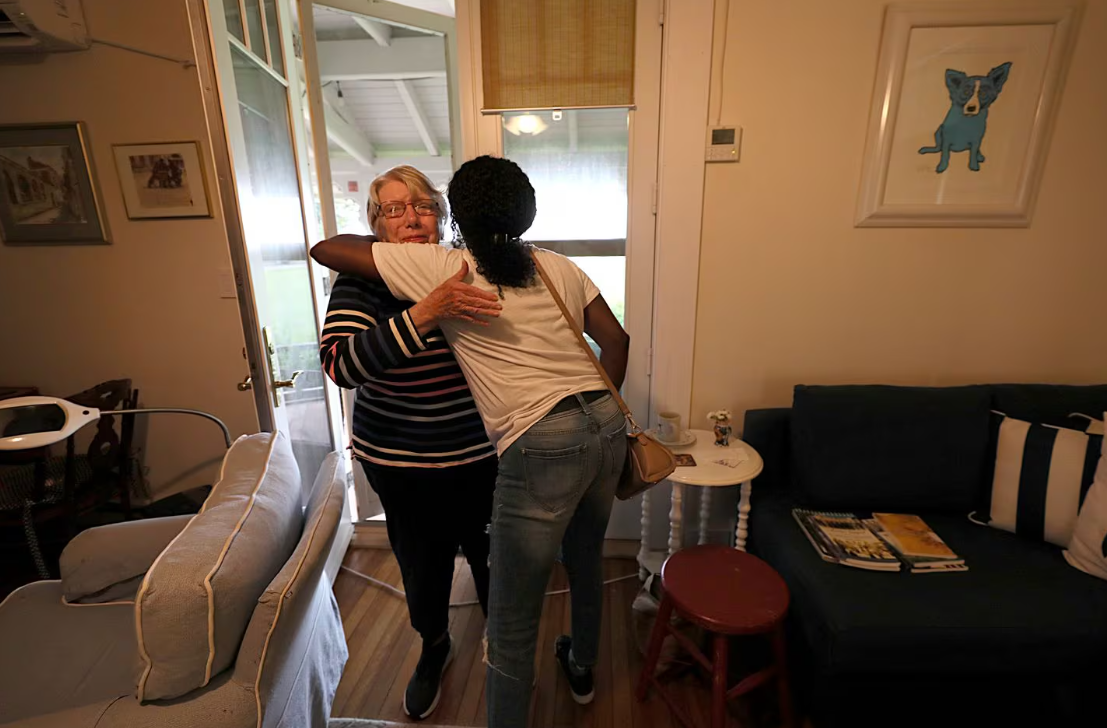马萨诸塞州在卫生劳动力危机中家庭服务和护理举步维艰

【中美创新时报2024 年 6 月 11 日编译讯】(记者温友平编译)在最近的一项马萨诸塞州调查中,超过一半的医院、行为健康提供者、疗养院和成人日托中心报告称,去年等待服务的患者数量与 2022 年相比有所增加。根据该州卫生信息与分析中心进行的调查,由于缺乏员工,近三分之二的行为健康提供者和超过一半的家庭护理提供者拒绝了客户。《波士顿环球报》记者杰森·劳克林(Jason Laughlin)对此作了下述报道。
如果他不时停下来喘口气,78 岁的理查德·安东尼诺(Richard Antonino )几乎可以为他的妻子玛丽(Marie)提供所有需要的护理。
阿尔茨海默病使她无法自己做很多事情,但安东尼诺有足够的力量将她从床上抱起来、给她穿衣服、给她洗澡和喂她。他确实需要帮助将玛丽从轮椅上抱起来去上厕所——他无法一直找到帮助。他的身体状况不如从前,慢性阻塞性肺病迫使他只能短时间用力。
“我需要帮助才能摆脱困境,”来自萨加莫尔的安东尼诺说。“科德角肯定缺少帮助。”
安东尼诺是马萨诸塞州居民中感受到医疗保健劳动力危机影响的居民之一,这场危机几乎影响到了该行业的每个部门。
在最近的一项州调查中,超过一半的医院、行为健康提供者、疗养院和成人日托中心报告称,去年等待服务的患者数量与 2022 年相比有所增加。根据该州卫生信息与分析中心进行的调查,由于缺乏员工,近三分之二的行为健康提供者和超过一半的家庭护理提供者拒绝了客户。
CHIA 执行董事劳伦·彼得斯 (Lauren Peters) 表示,短缺现象普遍存在,但在低薪职位中最为严重。例如,在马萨诸塞州,家庭护理助理的时薪通常约为 20 美元。缺乏愿意以如此高薪从事艰难工作的人员,使得那些最需要帮助的人,如老年人和残疾人,似乎永无止境地争夺服务。
在南波士顿,63 岁的吉姆·威斯(Jim Wice)使用轮椅,他非常需要帮助,他曾出钱让一位前助手从华盛顿州飞到波士顿来帮助他。他觉得自己陷入了寻找后备护理的循环中,以防他的主要护理人员失败。
“我一直在建立人际网络,”他说,“我一直在四处寻找谁可能是下一个 [个人护理员]。”
调查发现,家庭保健机构的直接护理人员、注册护士和社会工作者职位的空缺率为 20% 至 25%。养老院和成人日托中心的直接护理工作同样人手不足。
“[工人] 可以寻找功能更简单或工作更轻松的其他工作,”彼得斯说。 “我认为这些职位是最难填补、最难留住的,这并不奇怪。”
这项调查于 2023 年 5 月至 2024 年 1 月对从医院到牙科等医疗保健行业的提供者进行了调查,还发现某些工作的流动率高得惊人。在家庭保健和成人日托工作的所有注册护士中,几乎有一半在一年内离职。
“他们被要求看太多病人,回家的病人病情更严重,伤口也更复杂,”马萨诸塞州护士协会主席、麻省总医院重症监护室护士凯蒂·墨菲说。
彼得斯指出,空缺和流动率最高的工作也往往有最多的非白人工人。
CHIA 官员打算每两年进行一次调查,以跟踪劳动力的增长和收缩。
“这样做的动力实际上是为了获得有关医疗保健行业一些关键部门劳动力短缺的客观事实基础,”彼得斯说。
该调查还研究了解决方案。许多雇主表示,他们依靠更高的薪酬来促进招聘和留住员工;其他雇主则转向招聘奖金、灵活的工作时间和学生贷款减免。
“CHIA 的调查结果进一步证明,多样性、灵活性和福祉必须继续成为我们联邦劳动力工作的支柱,”马萨诸塞州卫生和医院协会主席兼首席执行官史蒂夫·沃尔什 (Steve Walsh) 在一份声明中表示。
据 MHA 报道,如果劳动力不足给临床医生带来额外压力或导致医院无法接收尽可能多的患者,则尤其令人担忧。该组织发言人萨姆·梅尔尼克(Sam Melnick )表示,这种情况正在一些医院发生,这使得工人短缺问题成为迫切需要关注的问题。
CHIA 调查发现,大型医院系统的执业护士空缺数量最多。非附属医院难以填补医疗技术人员的职位。
麻省总医院布莱根分院的急诊医学医师约瑟夫·科普(Joseph Kopp )表示,行为健康和其他专科护理提供者缺乏工作人员也间接影响了医院,这些提供者无法接受急诊科的转诊。有资格接受其他类型护理的患者堆积如山,导致大型医院出现危险的过度拥挤和长时间等待。
COVID-19 大流行加剧了本已令人担忧的医疗保健劳动力数量。2021 年,一项全国性调查发现护士普遍存在压力、焦虑和抑郁。 百分之十的人想完全辞职。护士工会主席墨菲强调,马萨诸塞州并不缺少注册护士。她说,护士离开医院是因为工作量太大。调查发现,在所有医疗保健部门中,17% 的注册护士职位空缺。
在包括行为健康、日间护理计划和家庭护理服务在内的卫生和人类服务部门,该州已投入大量资金解决劳动力短缺问题。其中包括 4600 万美元用于支持 84 家人类服务组织的劳动力发展,以及 1650 万美元用于偿还直接护理人员的学生贷款。行为健康行业迫切需要州政府释放近 2 亿美元的联邦疫情救济资金,用于行为健康计划,包括另一项巨额贷款偿还计划。
“最近的 CHIA 仪表板证实,我们专注于适当的优先事项,”HHS 发言人塞西尔·阿维拉(Cecille Avila)在一份声明中表示。
希利政府还提议投入 6.4 亿美元,以提高下一财年的人力和社会服务报销率。
科德角尤其受到低薪医护人员短缺的严重打击,其中许多人负担不起那里的生活费用。科德角和群岛老年人服务中心报告称,巴恩斯特布尔、杜克斯和楠塔基特县有 369 人正在等待任何家庭服务或增加服务,该组织的临床服务官员金·纳哈斯 (Kim Nahas) 说。
“这是一项非常具有挑战性的工作,而且薪水也不高,”她说。
83 岁的丽塔·巴尔斯 (Rita Barse) 来自玛莎葡萄园岛的橡树崖,她说,自 2022 年 11 月以来,她一直在等待医疗保险覆盖的家庭护理。巴尔斯近年来经历了几次健康挫折,包括艰难的膝关节置换手术和中风,但大部分时间都保持独立。不过,她说,洗澡很困难。她自掏腰包,每小时花 40 美元请私人服务人员帮忙,每周提供两到四个小时的帮助。在没有人来的日子里,她可能根本不洗澡。
巴尔斯的女儿伊莱恩(Elaine)经常帮忙,但因选择不足而感到沮丧。
“很多人认为这里都是超级富豪,”伊莱恩·巴斯(Elaine Barse )说。“还有一些人收入固定。你要付房租,还要做其他所有事情,剩下的钱不多了。”
萨加莫尔(Sagamore)的安东尼诺每周有四天请人帮助妻子上厕所。其他三天,他自己尽力而为。矛盾的是,他每天只需要大约一个小时的帮助,这让他的情况更加复杂。大多数家庭助理不会接受这么有限的时间。
他说,照顾他结婚近 60 年的妻子玛丽很累。他一有空闲时间就会睡着。但他不会把她送到养老院。他说,养老院人手也不够,而且服务人员工作过度。
“我正尽我所能不让我的妻子去那里,”他说。
题图:在帮助丽塔·巴尔斯(Rita Barse)(左)洗澡和穿衣后,助手米莉森特·考辛斯( Millicent Cousins )离开了一天。巴尔斯现年 83 岁,来自玛莎葡萄园岛的 Oak Bluffs,自 2022 年 11 月以来一直在等待由医疗保险覆盖的家庭护理。SUZANNE KREITER/GLOBE STAFF
附原英文报道:
Home services and nursing care struggle amid Mass. health workforce crisis, new survey shows
By Jason Laughlin Globe Staff,Updated June 7, 2024
If he stops to catch his breath from time to time, 78-year-old Richard Antonino can provide nearly all the care his wife Marie needs.
Alzheimer’s Disease left her unable to do much for herself, but Antonino is strong enough to get her out of bed, dress her, wash her, and feed her. He does need help getting Marie out of her wheelchair to use the bathroom — help he cannot consistently find. His body is not what it was, and COPD forces him to limit his exertion to short spurts.
“I need the help just to bail me out,” said Antonino, of Sagamore. “There definitely is a shortage of help on the Cape.”
Antonino is among the Massachusetts residents feeling the impact of a health care workforce crisis that has touched virtually every sector of the industry.
Well over half of the hospitals, behavioral health providers, nursing homes, and adult day cares who responded to a recent state survey reported an increase in patients waiting for services last year compared to 2022. A lack of staff caused almost two thirds of behavioral health providers and more than half of home care providers to reject clients, according to the survey, conducted by the state’s Center for Health Information and Analysis.
Shortages are widespread but most acute among lower paying positions, said Lauren Peters, CHIA’s executive director. Home care aides, for example, typically earn about $20-an-hour in Massachusetts. The shortage of people willing to do a difficult job at those wages leaves those who need the most frequent support, such as the elderly and those with disabilities, in a seemingly never-ending scramble for services.
In South Boston, Jim Wice, 63, who uses a wheelchair, was so desperate for assistance he once paid for a former aide to fly to Boston from Washington state to help him. He feels trapped in a cycle of hunting for backup care in case his primary caregivers fall through.
“I’m always networking,” he said, “I’m always looking around to see who might be a possible next [personal care attendant].”
Direct care workers, registered nurses, and social worker positions at home health care agencies have vacancy rates ranging from 20 to 25 percent, the survey found. Direct care jobs at nursing homes and adult day cares are similarly understaffed.
“[Workers] can go seek alternative employment with an easier function or easier jobs,” Peters said. “I think it’s really no surprise that these roles are the hardest to fill, are the hardest to retain.”
The survey, which polled providers in health care sectors ranging from hospitals to dentistry from May 2023 to January 2024, also found shockingly high turnover in some jobs. Almost half of all registered nurses working in home health care and adult day care left their jobs within a year.
“They are being asked to see too many patients, and patients are going home sicker, and with complicated wounds,” said Katie Murphy, president of the Massachusetts Nurses Association and an ICU nurse at Mass General Brigham.
Jobs with the highest vacancies and turnover rates also tend to have the most non-white workers, Peters noted.
CHIA officials intend to run the survey every two yearsto track growth and contractions in the workforce.
“The impetus for this was really to get an objective fact base around workforce shortages across some of the key sectors in the heath care industry,” Peters said.
The survey also looked at solutions. Many employers said they relied on better pay to boost hiring and retention; others turned to hiring bonuses, flexible hours, and student loan forgiveness.
“CHIA’s findings are further proof that diversity, flexibility, and wellbeing must continue to serve as the anchors of our workforce efforts here in the commonwealth,” Steve Walsh, president and chief executive of the the Massachusetts Health and Hospital Association, said in a statement.
Inadequate labor is particularly of concern if it puts added pressure on clinicians or prevents hospitals from admitting as many patients as they otherwise could, MHA reported. That is happening in some hospitals, said Sam Melnick, a spokesperson for the organization, making worker shortages an urgent concern.
Large hospital systems had the greatest number of vacancies among licensed practical nurses, the CHIA survey found. Unaffiliated hospitals struggled to fill medical technologist jobs.
Hospitals are also indirectly affected by a lack of workers at behavioral health and other specialized care providers who then cannot accept transfers from emergency departments, said Joseph Kopp, an emergency medicine physician with Mass General Brigham. The pileup of patients eligible for other types of care contributes to dangerous overcrowding and long waits at larger hospitals.
The COVID-19 pandemic exacerbated already worrisome health care workforce numbers. In 2021, a national survey found widespread stress, anxiety, and depression among nurses. Ten percent wanted out of their jobs entirely. Murphy, the nurses’ union president, emphasized there isn’t a shortage of RNs in Massachusetts. Rather, nurses leave hospitals due to overwhelming workloads, she said. Across all health care sectors, the survey found, 17 percent of registered nursing jobs are unfilled.
In the health and human services sector, which includes behavioral health, day programs, and home care services, the state has committed significant money to addressing the paucity of labor. That includes $46 million to support workforce development at 84 human services organizations and $16.5 million for student loan repayments for direct care workers. The behavioral health industry is desperate for the state to release close to $200 million in federal pandemic relief funds allocated for behavioral health programs, including another hefty loan repayment program.
“The recent CHIA dashboard confirms that we are focused on the appropriate priorities,” said Cecille Avila, a spokesperson for HHS, in a statement.
The Healey administration also proposed a $640 million commitment to increase human and social services reimbursement rates for the coming fiscal year.
Cape Cod is particularly hard hit by the shortage of lower-paid health care workers, many of whom can’t afford to live there. Elder Services of Cape Cod and the Islands reported 369 people in Barnstable, Dukes, and Nantucket counties waiting for any home service or an increase in service, said Kim Nahas, the organization’s clinical services officer.
“It’s very challenging work, and the pay is not where it needs to be,” she said.
Rita Barse, 83, of Oak Bluffs on Martha’s Vineyard, has been waiting since November 2022 for home care covered by Medicare, she said. Barse has had several health setbacks in recent years, including difficult knee replacement surgery and a stroke, but has mostly stayed independent. Showering is difficult, though, she said. She spends $40 an hour out-of-pocket on a private service that provides help two to four hours per week. On days when no one comes, she may not shower at all.
Barse’s daughter, Elaine, often helps, but is frustrated by the lack of options.
“A lot of people think there’s all these super wealthy people here,” Elaine Barse said. “There’s also the person who’s on a fixed income. You’re paying rent, and you’re doing all this other stuff, and there’s not a lot left over.”
Antonino, the Sagamore man, has someone assist his wife with toileting four days a week. The other three days, he does his best on his own. It complicates his situation, paradoxically, that he only needs help for about an hour a day. Most home aides won’t accept such limited hours.
Caring for Marie, his wife of nearly 60 years, is exhausting, he said. He tends to fall asleep when he has down time. But he won’t put her in a nursing home. Those are understaffed too, he said, and the providers are overworked.
“I’m doing my best to keep my wife out of there,” he said.

